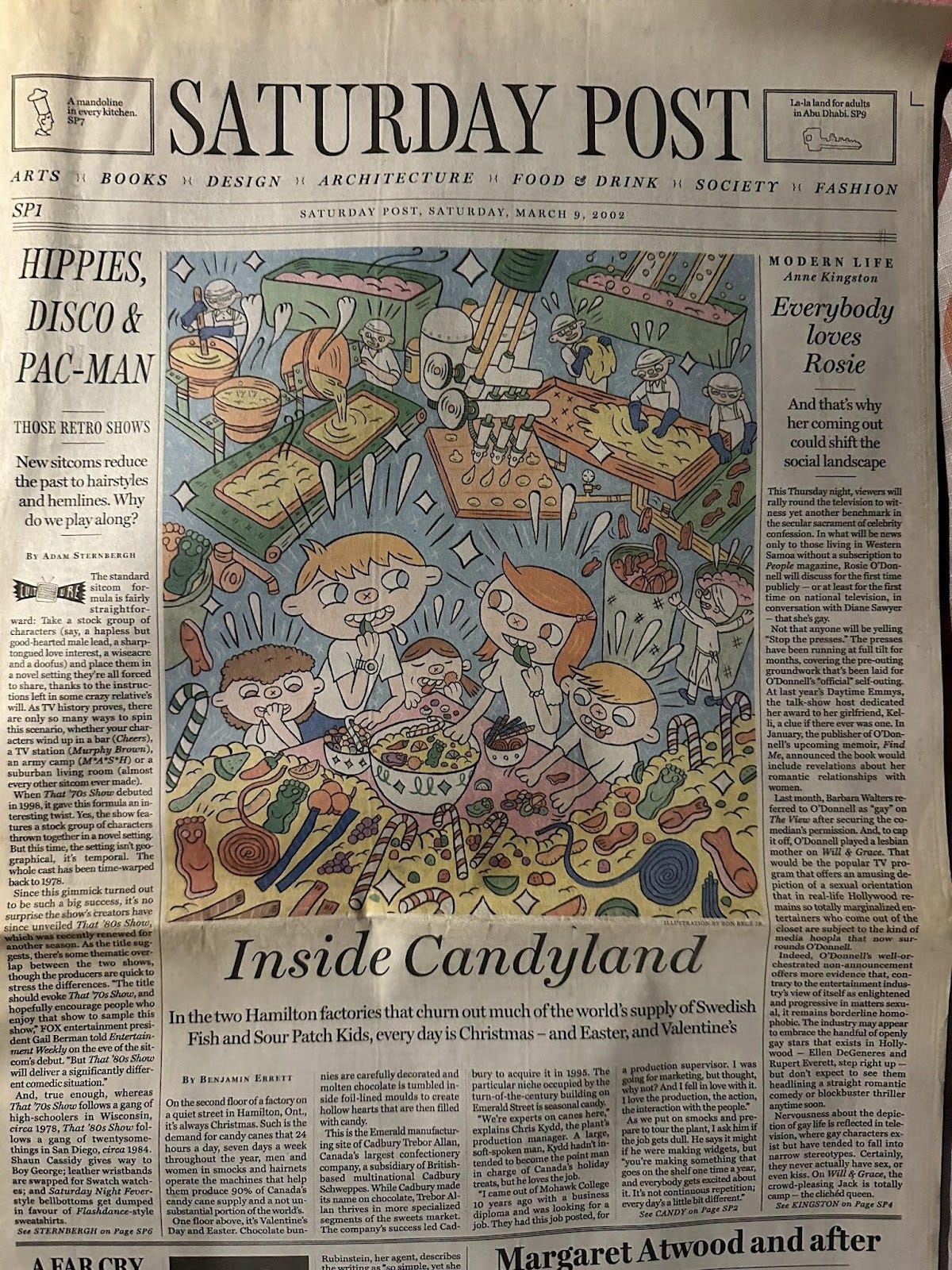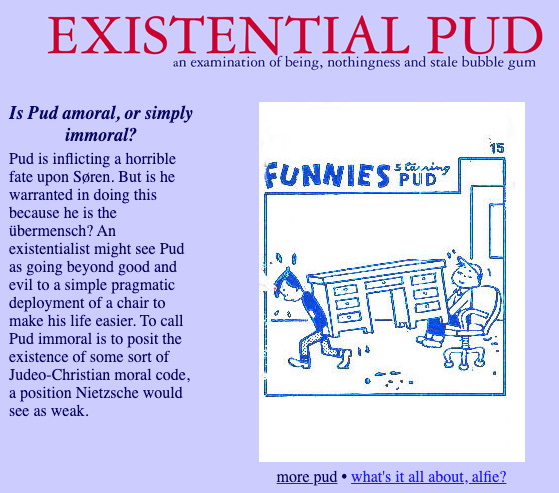The Wit's Guide to Candy
Or, Sucrose Sucrose Ghali
“Candy is dandy …”
— Ogden Nash
And we all know the 1931 poem “Reflections on Ice-Breaking” ends with “but liquor is quicker.” Less well known is Nash’s 1968 addition: “Pot is not.”
This is just about the only entry on candy found in my vast library of quotation dictionaries, probably because after a certain age most of the Great Wits preferred their sugars fermented.
So let me instead draw upon my rich personal history of refined sugar ingestion, starting with my deeply reported 2002 Saturday Post cover story headlined Inside Candyland:

This feature was pegged to the following bit of news: Sour Patch Kids are the best candy out there, and they are made in Hamilton, Ontario. OK, this isn’t exactly news, but it is verifiably true and was reason enough for me to rent a car and drive to both the Ewen and Emerald manufacturing sites of what was then called Cadbury Trebor Allan and is now Mondelēz, a name that sounds vaguely Spanish but is actually corporatese, right down to the fake accent.
Anyway, my piece from 21 years ago (!) is frontloaded with needless detail about how they make seasonal candy two seasons ahead, but then it gets to the good stuff, specifically how the great sour candies are made with starch and not gelatin, and parbaked to create a crusty outside and a gooey inside. And also this bit on how they invented Fuzzy Peaches in the early 1990s:
“We’re always going through grocery stores and looking at what’s new and popular,” said Carol Mushing, the marketing manager who was known by neighbourhood kids as the Gummy Queen for her legendary Halloween offerings. “At the time, peach schnapps was very popular. We aren’t averse to looking at trends in the liquor store, so we brought that in.”
So liquor was quicker to market, but Mushing accurately claimed that Fuzzy Peaches are dandier: “If you close your eyes and bite into a peach, you can imagine the fuzz on the outside. We delivered on that by giving that nice tartness to the candies.”
“We have not journeyed all this way across the centuries, across the oceans, across the mountains, across the prairies, because we are made of sugar candy.”
— Winston Churchill
Of course Charlie and the Chocolate Factory was why I wanted to visit the Sour Patch, and I first heard the candy-is-dandy line spoken by Gene Wilder in the unbeatable 1971 film version. The problem with every subsequent spin on Roald Dahl’s classic — almost certainly including the upcoming Wonka starring Timothée Chalamet as Willée himself — is that they focus on Freudian origin stories when all we really want is snozzberries that taste like snozzberries. (It’s the same way they ruined James Bond, as per Anthony Lane: “Who wants a hero who expires under the sheer weight of backstory?”)
At the risk of doing that, let me here quote from a posthumously published essay Dahl wrote to explain his fascination with candy. He explained that when he was very young, all the candy was bad — “the liquorice was made from rats’ blood and the sherbet from sawdust.” But then he had the great good fortune to live through what he called The Chocolate Revolution.
“From 1930 to 1937 virtually all the great classic chocolate bars were invented and they are still on the bestseller list,” he writes, rhyming off Crunchie, Kit Kat, Mars, Milky Way, Rolo and Aero. And here’s the line that stuck in the molars of my mind like a Butterfinger: “In music, the equivalent would be the golden age of Bach, Mozart and Beethoven. In painting, it was the equivalent of the Italian Renaissance and the advent of Impressionism at the end of the 19th century; in literature, Tolstoy, Balzac and Dickens.”
“Venice is like eating an entire box of chocolate liqueurs in one go.”
— Truman Capote
A brief list of candy metaphors: Nose candy is cocaine. Arm candy is an attractive plus one. Eye candy is an attractive anything. Brain Candy is the fifth-best Canadian comedy of all time.
“I quit smoking and started to munch molasses candy instead, with the result that my weight went up from my usual 140 to a monumental and cheerful 200. In consequence, I am one-third American — good American flesh keeping me warm and safe.”
— Vladimir Nabokov
The wittiest chewing gum was never Bazooka Joe, with his broadly unfunny comics, but rather Pud, the also-ran that aspired to a Zen-like humour in its gags. What is the sound of one jaw chewing?
In 2001 I channeled the learnings of my last undergraduate course, Existentialism and Buddhism, into the website ExistentialPud.com. Thanks to the Wayback Machine, I found it with relative ease:
In retrospect, I was crushing Pud under the sheer weight of backstory. Let candy be candy. Or as Pud would have it:
FYI, Paying Subscribers Get Monthly Art Postcards
Figured I’d try the direct approach for once: Send me C$6/month by clicking the button below and I’ll send you the first six Riposte Cards, limited edition 4x6 art prints specially commissioned by yours truly for the person reading this sentence — and then I’ll send you another one each month till well into the future. It’s like getting 12 Picassos for the price of a Pud!
Quote Vote
“sometimes in its box of sky lavender and cornerless, the moon rattles like a fragment of angry candy.”
— e.e. cummings
Next week, it’ll be time to put down the candy and pick up a textbook — which you will have cleverly hollowed out and stuffed with Orchard Pears.
That was Issue No. 216 of Get Wit Quick, the newsletter that creepily hasn’t missed a week since 2019. For real! If there were a United Nations of candy, the Secretary General would be Sucrose-Sucrose Ghali, as my pal Tristan always says. My mother calls Fuzzy Peaches Woolly Mammoths, and it makes a certain kind of sense. My book Elements of Wit: Mastering The Art of Being Interesting barely mentioned candy, but Elements of Taste: Understanding What We Like and Why was full of it. And I didn’t even mention those chalky Valentine’s ❤️ candies.






I don't know if you were simply being modest, but I wanted to read the whole Post article! Anyway, again loved starting the day this way.